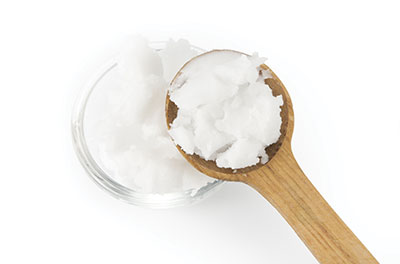
A touch of the tropics
May 2, 2013
By Julie Fitz-Gerald
We’re nearly halfway through the year, and coconut oil is proving to be one of the big trends.
We’re nearly halfway through the year, and coconut oil is proving to be one of the big trends. Chefs, bakers and consumers alike are busy experimenting with this tropical oil as a replacement for butter and more traditional oils. But, how well does it work?
 |
|
| Coconut oil can be used as a butter replacement for cookies and other baked goods.
|
While proponents of coconut oil cite a long list of health benefits, including stress relief, increased immune function, higher metabolism, weight loss, and a reduction in kidney problems and heart disease, the medical community is still on the fence about how healthy it really is. The debate centres on coconut oil’s high saturated fat content of almost 90 per cent. The Heart & Stroke Foundation and Canada’s Food Guide recommend that Canadians drastically limit their saturated fat intake because of its link to increased levels of LDL cholesterol or “bad” cholesterol. The difference with coconut oil, however, is that its saturated fat content is made up of medium-chain fatty acids, which are smaller molecules that are easily digested by the body and converted into energy. This is in contrast to long-chain fatty acids that make up the saturated fat found in most other vegetable and seed oils, as well as in butter. Long-chain fatty acids are large molecules that the body has trouble breaking down, ultimately storing them as fat and contributing to higher levels of LDL cholesterol.
Interestingly, coconut oil has been heavily used in Pacific Island populations for centuries, where heart health is surprisingly good. According to an article printed in The Huffington Post by Dr. Joseph Mecola on March 4, Pacific Island populations get 30 to 60 per cent of their total caloric intake from saturated coconut oil, yet they have nearly non-existent rates of cardiovascular disease. It is perhaps data like this that has consumers drawing their own conclusions on the product, however it must be kept in mind that cultural biology can play a roll and comparing North Americans to Pacific Island populations may be akin to apples and oranges. Judging by the coconut’s recent popularity in the United States and Canada, a large number of people are buying into its health benefits as we’ve seen with the recent surge in coconut water products.
What’s it like to bake with?
The oil comes in solid form and melts when heat is applied, with a high melting point of 24 C (76 F). It has a smoke point of 177 C (350 F), so it can only be used for certain frying applications below that temperature, such as pan searing. Christopher Ennew, C.C.C., executive chef at Ste. Anne’s Spa, has been experimenting with coconut oil over the last few months and loves the life that it breathes into his dishes. The mellow, pleasant taste that the oil affords to his baking and cooking has been garnering a great response from guests at the spa.
 |
|
| Coconut oil becomes runny when heated. |
“The response has been very positive, especially for those who have allergies. And then there’s the alternative eater who wants to try different things and wants to experience something more interesting with their food. It satisfies different palates and tastes.”
Ennew has been using coconut oil in various applications, including soups, warm couscous or quinoa salads, brownies topped with dairy-free icing, and cookies, to name just a few. Used as a butter substitute, the oil has also been satisfying the growing needs of dairy-free and vegan diners alike.
“The biggest benefit is to accommodate more of my guests with their health issues. When I see a smiling guest enjoying a dish that they haven’t been able to have in a while due to a health issue or diet choice, it’s very exciting.
Food is a huge part of people’s lives.”
Because the oil begins to solidify as soon as it’s exposed to cooler temperatures, it is tricky to use in salad dressings.
However, Ennew has found that by bringing greens to room temperature prior to serving, he still has success with the oil in this application. Because coconut oil reacts differently depending on the application and is not a straightforward exchange for butter or other oils, Ennew suggests experimenting with it in small recipes to start.
“Like with any new product, use small recipes. Substitute a small amount in the beginning, start with half and work your way up until you get the texture and flavour that you want, because every product reacts differently when added to other things. Sugar and flours play a big part, so you have to take your time with it. There are a lot of people out there who have already done a lot of work on it, so you don’t have to reinvent the wheel. You can get on some blogs and see how others fared.”
When selecting a coconut oil, remember that not all are made equal. According to www.coconutoil.com , a source for original and peer-reviewed research on the subject, there are two types of coconut oil on the market today: refined and virgin. Refined coconut oil is bleached and deodorized to eliminate the taste and smell of the coconut. Virgin coconut oil is achieved by pressing the oil out of fresh coconut meat, without using chemicals or high heat for further refining.
Manufacturing virgin coconut oil generally is done in two ways: cold-pressing and wet-milling. Cold-pressed coconut oil is created through the process of quick-drying fresh coconut meat and then mechanically pressing out the oil. It is the most common type of virgin coconut oil on the market today. Wet-milling is the process of extracting oil from fresh coconut meat that has not been dried first. The coconut meat is pressed in order to squeeze out the coconut milk, which is then further separated to divide the oil from the water. Some coconut oil is labelled “extra virgin,” but keep in mind that there is no set industry standard for the use of this term.
The price point
Here’s a look at a couple different cost options, just to give you an idea of how it compares to what you’re currently using. A popular coconut oil among consumers, according to online forums and blogs, is Tropical Traditions Gold Label Virgin Coconut Oil, which is certified organic. In Canada, health food distributor T.T. Ultimate Products sells this oil in a five-gallon pail for $445 and a one-gallon pail for $121.95. Alternatively, Nutiva’s Organic Extra Virgin Coconut Oil can be purchased in Canada in one-gallon quantities for $59.99. Coconut oil can also be found in the health food section of many grocery stores in smaller quantities.
With consumer knowledge and demand for coconut oil increasing, it could prove to be a trend with staying power. Adding a taste of the tropics to your dishes may provide just the boost that you’ve been looking for. Ennew encourages others to try it out for themselves.
“It’s an enjoyable product to work with and you only need a little bit, so I would say, give it a whirl, give it a try. I was quite surprised when I first started using it and I was quite excited about coming up with something different that I could make. Offering somebody a dish or dessert that they haven’t been able to have for a couple of years because of allergies or illness: it’s exciting to see a smile on someone’s face when you get to do that.”
Julie Fitz-Gerald is a freelance writer based in Uxbridge, Ont., and is a regular contributor to Bakers Journal.
Print this page
Leave a Reply